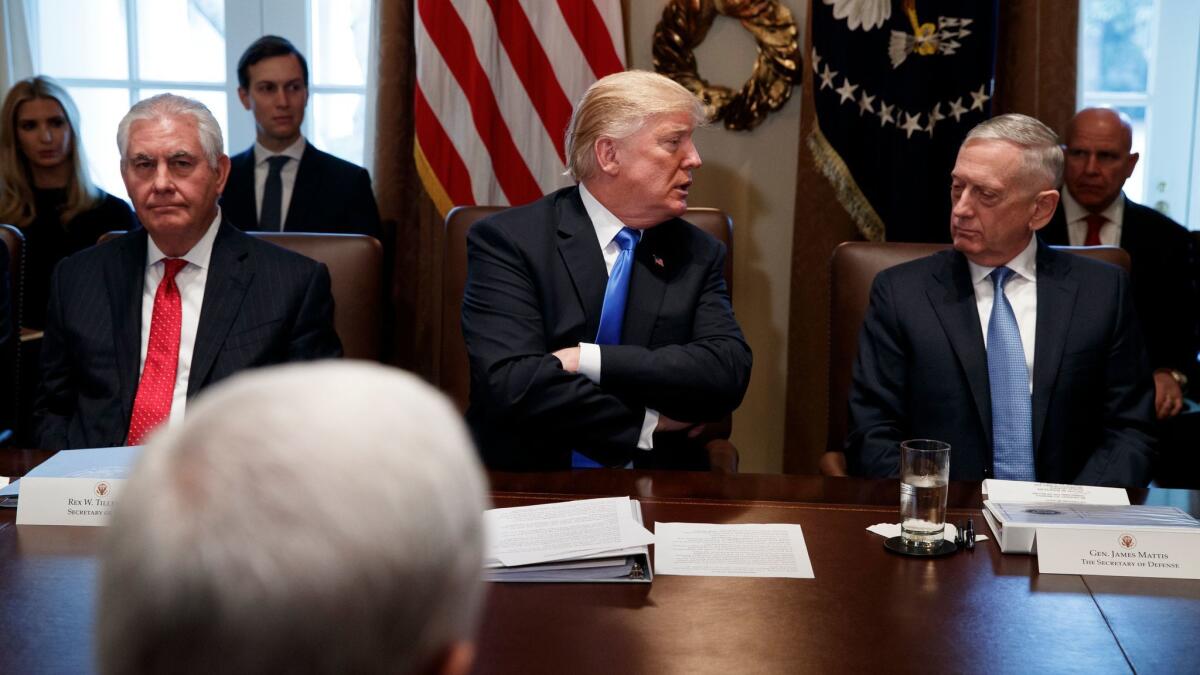Op-Ed: Do the Trump administration hawks understand the difference between North Korea’s nuclear capability and its intent?

- Share via
Secretary of Defense James Mattis is rarely at the forefront of saber-rattling where North Korean nuclear development is concerned. While National Security Advisor H.R. McMaster speaks recklessly of preventive war as an option of ever-increasing probability, Mattis is typically more measured, consistently boosting diplomacy as a viable — and indeed preferable — solution to Washington’s quarrels with Pyongyang.
That habit of comparative prudence makes all the more notable the Defense secretary’s intimation in comments last Friday that he is prepared to launch a preventive strike on North Korea if the regime is “shown to be a capable threat against us.” Pyongyang’s nuclear armament has yet to reach that stage, Mattis said, but his suggestion was that capability could be the Trump administration’s trigger to abandon deterrence and diplomacy in favor of military intervention.
That is a dangerous and foolhardy position, and a surprising one coming from a strategist of Mattis’ experience. What matters — or rather, what should matter — in Washington’s policy toward North Korea is not only capability but also intent.
To conflate nuclear capability and threat is to disastrously misunderstand the demented game Kim Jong-un is playing.
No one of good conscience wants the Kim Jong-un regime, infamous for its internal cruelty and external bluster, to have the nuclear capability Kim seeks. But capability alone is not a threat to America. It is certainly not a threat that justifies starting an avoidable war that may well bring the unthinkable devastation of nuclear warfare into the 21st century.
The error in conflating capability and threat is instantly evident when we consider other nuclear-capable states with which Washington has tense relations.
Russia and China, hardly close American allies, have substantial nuclear arsenals and far more reliable means of warhead delivery than North Korea possesses. Both nations have the capability Mattis describes, but because they show no evidence of intent to use it against the United States, Mattis would no doubt agree a preventive strike against either would be preposterous.
The comparison is far from exact. There are real differences between North Korea and Russia or China (though it is worth noting both aid the rogue Kim regime). Still, what is true of these nuclear powers is true of North Korea as Pyongyang’s capability grows: For Washington to confuse capability with the threat posed by intent to strike would be a grave error.
To his credit, even in these remarks, Mattis does not represent the most misguided voice on North Korea policy on offer. That dishonor may well go to Sen. Lindsey Graham (R-S.C.), who proclaimed in a recent Atlantic interview there is a 70% chance of a preventive U.S. strike on North Korea should the Kim regime conduct an additional nuclear weapons test.
Graham does not appear to distinguish between a successful and unsuccessful test. In other words, his standard for a preventive strike is not Mattis’ capability red line; all Graham requires is the desire for capability, not capability itself (let alone intent). But North Korea has already demonstrated the desire for capability –– one more test changes nothing in this regard. By the senator’s unhinged standard, the conditions for a preventive strike are already met.
Graham also appears to be undaunted by the prospect of plunging the United States into total war. “War with North Korea is an all-out war against the regime,” he told the Atlantic. “There is no surgical strike option. Their [nuclear-weapons] program is too redundant; it’s too hardened; and you gotta assume the worst, not the best. So if you ever use the military option, it’s not to just neutralize their nuclear facilities — you gotta be willing to take the regime completely down.”
In one sense, this honesty is refreshing: Graham is right that attacking North Korea would mean massive war, perhaps even great power conflict, with human suffering on a scale most alive today have never witnessed. Cornered by forcible, U.S.-orchestrated regime change — the very outcome his nuclear ambitions are intended to prevent — Kim could kill and maim millions on the theory that he may as well take as many innocents down with him as he can.
Graham appears to understand the horror that war with North Korea would entail and nevertheless remains enthusiastically hawkish. That alone should discredit him as a foreign policy advisor. Yet by his own account, Graham and the president talk North Korea “all the time” out on the golf links. His potentially pernicious influence makes it even more necessary for Mattis to recognize the distinction between capability and threat.
There is reason to believe North Korean is fundamentally engaged in a “huge game of blackmail,” as retired Col. Andrew Bacevich, a military historian, explains. Kim presides over “an exceedingly weak and arguably very fragile regime,” Bacevich says, and his “principle objective is to remain in power.”
Kim is not on a suicide mission, as he would be if he intended to attack the United States. His mission is to stay in charge, an outcome he believes is best secured by the capability to make U.S. invasion inconceivable. To conflate nuclear capability and threat is to disastrously misunderstand the demented game Kim is playing. It is a miscalculation for which millions may pay with their lives.
Bonnie Kristian is a fellow at Defense Priorities. She is a weekend editor at the Week and a columnist at Rare. bonniekristian.com
Follow the Opinion section on Twitter @latimesopinion and Facebook
More to Read
A cure for the common opinion
Get thought-provoking perspectives with our weekly newsletter.
You may occasionally receive promotional content from the Los Angeles Times.









